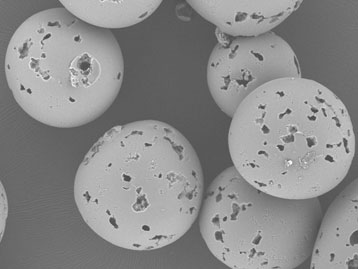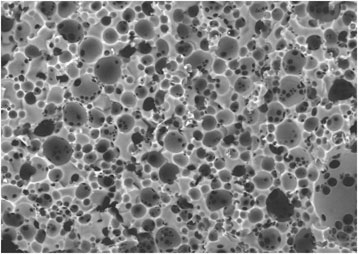| Posted: Dec 22, 2014 |
Ultrasounds dance the 'moonwalk' in new metamaterial
|
|
(Nanowerk News) Metamaterials have extraordinary properties when it comes to diverting and controlling waves, especially sound and light: for instance, they can make an object invisible, or increase the resolving power of a lens. Now, researchers at the Centre de Recherche Paul Pascal (CNRS) and the Institut de Mécanique et d'Ingénierie de Bordeaux (CNRS/Université de Bordeaux/Bordeaux INP/Arts et Métiers ParisTech)1 have developed the first three-dimensional metamaterials by combining physico-chemical formulation and microfluidics technology2.
|
|
This is a new generation of soft metamaterials that are easier to shape. In their experiment, the researchers got ultrasonic oscillations3 to move backwards while the energy carried by the wave moved forwards. Their work opens up new prospects, especially for high-resolution imaging (ultrasonography). It is published on 15 December 2014 in the journal Nature Materials ("Soft 3D acoustic metamaterial with negative index").
|
 |
| Silicone beads embedded in a water-based gel (photograph is ~2 cm across). (© CRPP)
|
|
Since the 2000s, the international scientific community has seen interest in metamaterials and their extraordinary properties grow exponentially. A metamaterial is a medium in which the phase4 velocity of light or sound waves can be negative (the material is said to have a negative refractive index). In such a medium, the phase of the wave (the successive oscillations) and the energy carried by this same wave move in opposite directions. This property is not found in any natural homogeneous medium.
|
|
To obtain a metamaterial, it is necessary to make a heterogeneous medium that contains a large number of inclusions (known as microresonators). The usual way is to use micromechanical methods (etching, deposition, etc) to machine solid supports that will have the properties of metamaterials in one or two dimensions. However, this method cannot be used to work with soft matter at the micrometer scales required for ultrasounds, and the materials obtained remain limited to one or two dimensions. |
 |
| Scanning electron microscope image of porous microbeads with diameters of approximately 300 µm. (© CRPP)
|
|
In this study, the researchers developed a new type of metamaterial, in the fluid phase, formed of porous silicone microbeads embedded in a water-based gel. This metafluid is the first three-dimensional metamaterial to work at ultrasonic frequencies. In addition, due to its fluid nature, it can be made using physico-chemical processes and microfluidics technologies, which are much easier to implement than micromechanical methods.
|
|
One of the properties of porous media is that sound travels through them at very low speed (a few tens of meters per second) compared to water (1500 meters per second). Due to this sharp contrast, the whole suspension has the properties of a metamaterial provided the bead concentration is sufficient: when the researchers studied the propagation of ultrasonic waves through this medium, they directly measured a negative refractive index. Within such a metafluid, the energy carried by the wave travels from the emitter to the receiver, as expected, whereas the oscillations appear to move backwards in the opposite direction, rather like a dancer doing the 'moonwalk'.
|
 |
| Scanning electron microscope image of the interior of a microbead, with numerous micrometer-scale pores (photograph is ~0.1 mm across). (© CRPP)
|
|
These results open the way to numerous applications ranging from high-resolution ultrasound imaging to sound insulation and stealth in underwater acoustics. In addition, the soft-matter physico-chemical techniques used to make this metamaterial makes it possible to produce fluid or flexible materials with adaptable shapes, potentially at the industrial scale.
|
|
Notes
|
|
1 In collaboration with the Laboratoire du Futur (CNRS/Rhodia/Université de Bordeaux)
|
|
2 Microfluidics is the science that consists in manipulating fluids on the micrometer scale.
|
|
3 High-frequency acoustic waves (over 20 kHz) used in ultrasonography, underwater acoustics (sonar) and by some animals (bats).
|
|
4 The phase of a wave refers to the successive oscillations of the medium.
|



